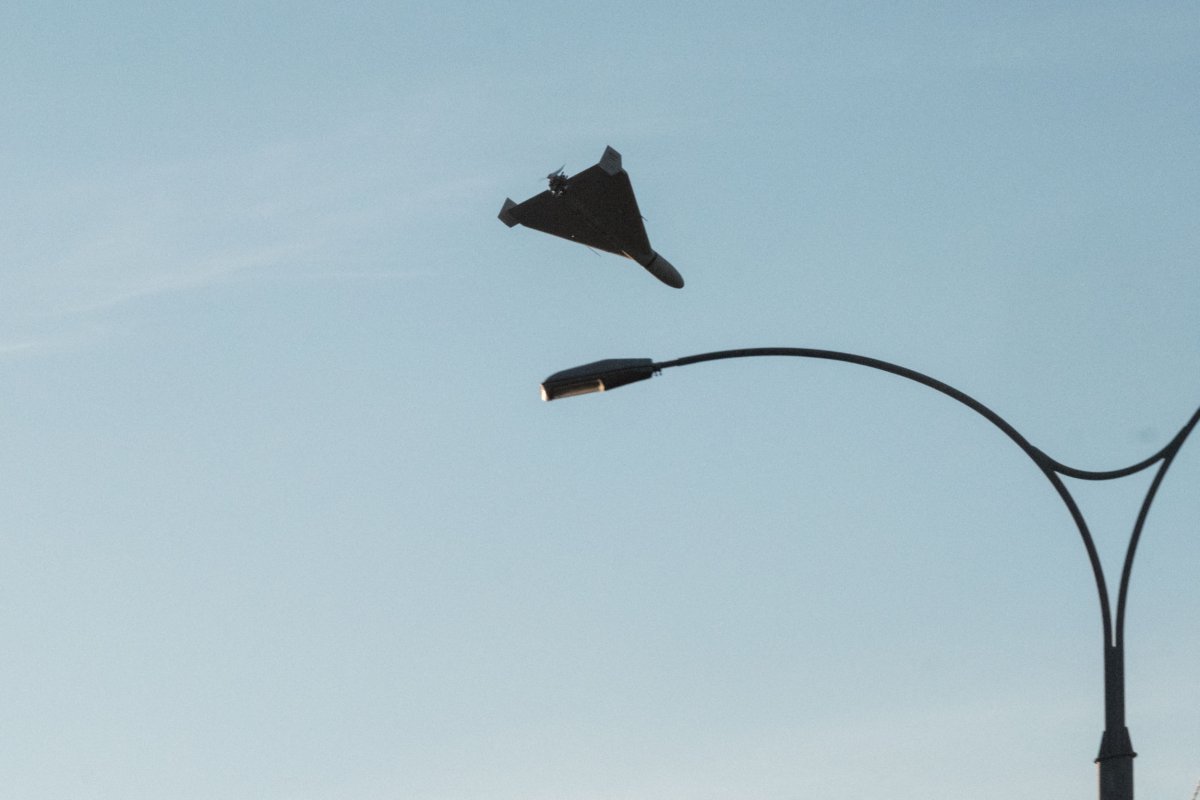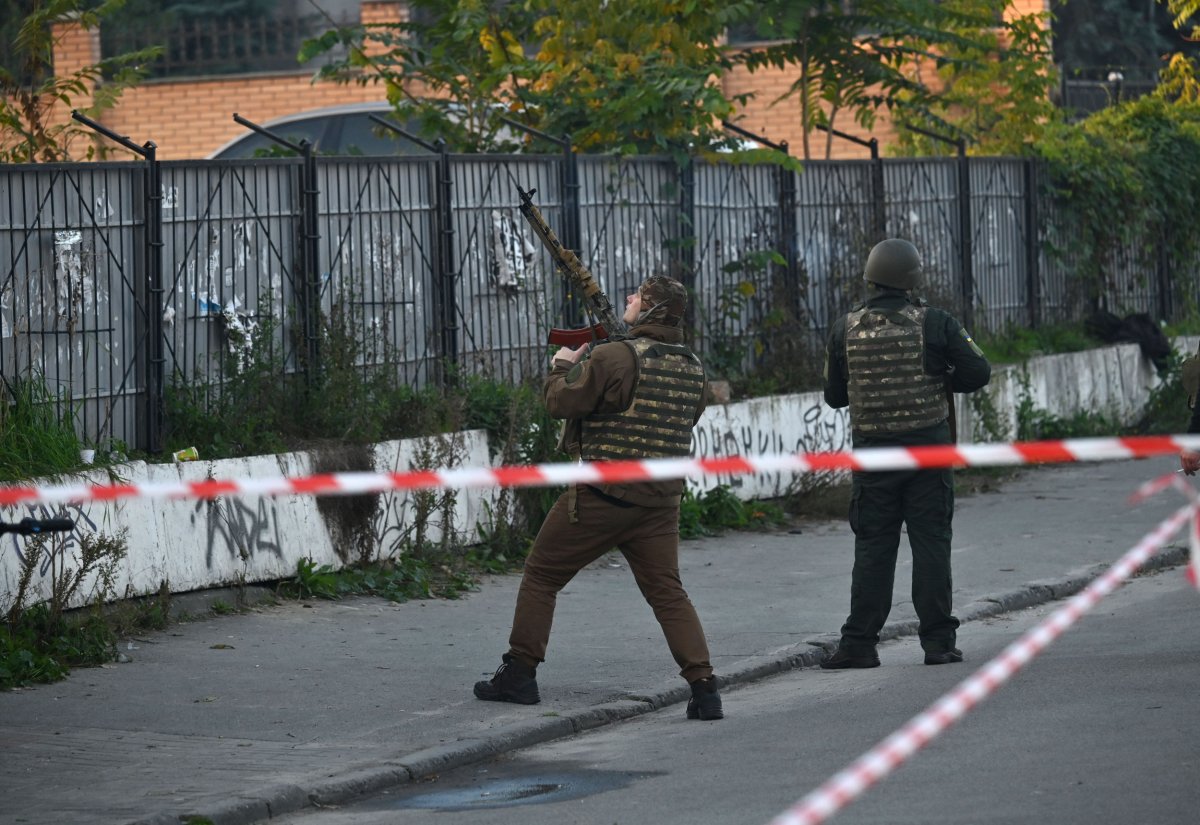Iranian-made drones falling on Ukrainian cities are the most visible signifiers to date that Russia is not acting alone in its 10-month-old invasion of its neighbor. On Friday morning, Shahed-136 UAVs were again fired at Kyiv and other parts of the country.
Ukraine's Air Force said 16 drones were shot down, with debris from one damaging a building in the nation's capital.
Hundreds of Iranian drones, primarily the Shahed-136 "kamikaze" UAV—known as the Geran-2 by Russian operators—are believed to now be in Russian service, with more on the way. Russia is reportedly planning to open a new drone factory to produce Iranian designs within its own borders.
The drones are an important signifier of Tehran's political support for Russia. They are unlikely to change the strategic balance of the conflict but are deepening the misery of Ukrainians now living under the constant threat of Russian bombardment, even far from the front lines.

Who makes the Shahed-136 drones?
The Shahed-136 is made by the Shahed Aviation Industries Research Center, which has ties to the Islamic Revolutionary Guards Corps Aerospace Force and the government-owned Iran Aircraft Manufacturing Industries Corporation.
The Shahed-136 officially entered service with the Iranian military in 2021. But the drone, its variants, and predecessors have reportedly also been used by Houthi forces fighting in Yemen in recent years. Houthi rebels have with Iranian support pioneered the use of swarm UAVs to attack Saudi military and infrastructure sites, at times with great success.
Having denied supplying the weapons for months, Tehran admitted in November that a small number of UAVs were sent to Russia before the February invasion. Iran maintains that this supply has now stopped.
Kyiv alleges that Russia has placed an order for at least 2,400 Shahed-136 UAVs, which are being delivered in batches.
The Washington Post, citing unnamed Western security officials, reported in November that Moscow and Tehran had reached a deal for Iranian drones to be mass-produced within Russia. The production line could be up and running within months, the report said.
Newsweek reached out to the Iranian and Russian foreign ministries for comment.
How do Shahed-136 drones work?
The triangular-shaped drones are 11 feet long and weigh 440 pounds, with a wingspan of 8.2 feet. The Shahed-136 carries a warhead weighing between 66 and 110 pounds—typically a combination of high explosives and fragmentation components. Their maximum range is believed to be between somewhere 1,000 and 1,600 miles.
The drones are slow, with a top speed of around 115 mph, and are large and noisy. Their loud piston engines have earned them the nicknames of "flying moped" or "lawnmower" among Ukrainians. This helps make the drones relatively easy to spot and intercept on an individual basis.
But the weapons are designed to be used in "swarms," fired in a salvo from racks that can hold five UAVs. Ukrainian troops at the front lines report the drones being used in pairs, making it more difficult to protect the target, while anti-air units defending Ukrainian cities have been faced with dozens at a time.
Costing somewhere between $10,000 and $50,000 per unit, they are cost-effective even if the majority of a swarm is destroyed before they reach their targets.
The original Shahed-136s were fitted with a simple inertial guidance system, using motion and rotation sensors plus a computer to seek its target. But reports indicate that the latest Russian-flown craft uses GLONASS control units, significantly increasing accuracy and their potential to loiter above a target area before diving down to strike.
United States and Ukrainian officials have alleged that Iranian personnel is on the ground in Russia to assist with Shahed-136 launches. U.S. National Security Council spokesperson John Kirby said "a relatively small number" of Iranian specialists are present in Crimea to improve Iranian drone performance.
Pentagon spokesman Brigadier General Pat Ryder said the Iranians are "assisting" the Russian personnel who pilot the UAVs.
Oleksiy Danilov, the secretary of Ukraine's National Security and Defense Council, said in November that several Iranians had been killed in a Ukrainian strike on positions in occupied Crimea.
How are Shahed-136 drones being used in Ukraine?
The Shahed-136 drones are mostly being used against infrastructure targets in and around major Ukrainian cities. Settlements in Odesa, Mykolaiv, Dnipropetrovsk, Zaporizhzhia, Vinnytsia, Khmelnytskyi, Cherkasy and Kyiv regions have all been targeted in recent months.
The Russians and their Iranian backers appear to be trying to adapt to Ukraine's air defense capabilities. In Friday's attack, Ukrainian defense officials said the drones were flown from multiple directions and tried to break through air defenses by following the Dnipro river towards the capital.

Drones are a powerful psychological weapon. Erik—who did not wish to give his full name for security reasons—is a U.S. volunteer with the Mozart Group helping train Ukrainian troops and evacuate civilians from front-line areas. He told Newsweek that Russia's use of Iranian drones, and the nationwide barrages more generally, are "affecting morale."
"Obviously it's hurting the infrastructure, but the Ukrainians are also rebuilding pretty quickly and adjusting. Anticipating attacks, they shut down the grid or partially shut down the grid. But as far as being surgical instruments that take out things, not as much," Erik said.
Their unsophisticated nature makes the drones better for use against large and static targets, rather than smaller and mobile military ones. As such, their use on the front lines appears to be less common. There, cheaper, commercial, largely Chinese-made drones are more commonplace.
"It looks like they're using the Iranian drones just for the deep strikes against civilian infrastructure," Erik said of Russian forces. "They're saving their stockpile, they're not using them on the front line."
There were a handful of reports of the successful use of Shahed-136s against the Ukrainian military earlier this year. In September, Rodion Kulahin—the commander of artillery of Ukraine's 92nd Mechanized Brigade—told The Wall Street Journal that Shahed-136s operating in pairs destroyed hour howitzers and two armored personnel carriers in the Kharkiv region.
And in October, a Shahed-136 reportedly hit a barracks of the 72nd Mechanized Brigade in Bila Tserkva near Kyiv.
How can Shahed-136 drones be stopped?
The unsophisticated nature of the drones actually poses a challenge to interception. It is not cost-effective for multimillion-dollar surface-to-air missiles to shoot them down, and the UAVs are too small and low-flying to be reliably picked up on radar by Ukrainian MiG-29 fighter jets and destroyed with air-to-air missiles. Instead, pilots must use their cannons from close range, imperiling the fliers, aircraft, and civilians below. This is especially challenging at night.
Less advanced weapons have proven more effective. Major General Borys Kremenetsky, the defense attaché at the Ukrainian embassy in the U.S., said in October that SA-8 surface-to-air missiles have been successful in stopping the drones, as have the autocannons of the Soviet-made ZSU-23-4 Shilka platform and the German-supplied Flakpanzer Gepard SPAAGs.
Oleksandr Merezhko, a Ukrainian lawmaker and chair of the parliament's foreign affairs committee, told Newsweek that "our air defense has become more effective in shooting down those drones."
"Before, those drones would inflict serious damage to our power grid and we would have blackouts for a whole day or more. Now, after yesterday's drone attack, we don't have a blackout in the part of Kyiv where I live," Merezhko said.
"At the same time, those drones have been flying along the river Dnipro in Kyiv which makes them difficult to spot and destroy. I hope that our allies and friends will provide us with contemporary air defense and anti-missile systems which will minimize damage done by the drones."

Ukraine is also looking into using counter-drones. In November, the head of the Ministry of Digital Transformation and Deputy Prime Minister Mikhail Fedorov told Forbes that Kyiv is considering a range of "Shahed catchers" that can track and ram incoming Iranian drones, destroying them in flight.
Fedorov said this week that Ukraine has acquired some 1,400 drones, largely for reconnaissance, though it has plans to develop additional strike drones and UAVs capable of air-to-air interceptions.
Meanwhile, Kyiv's foreign partners are looking to tighten sanctions on both Russia and Iran in a bid to strangle drone development.
Studies by Conflict Armament Research have found that Russian and Iranian drones being used in Ukraine are "highly reliant on components produced by companies based in Europe and the United States." CAR found in an October review of downed UAVs that 82 percent of their components were manufactured by companies based in the U.S.
The White House has now launched a task force dedicated to curtailing the use of Western technology in Iranian-Russian drones, CNN reported. The New York Times detailed a broad anti-drone effort, with the U.S. seeking to choke Iran's drone industry while also helping the Ukrainians target launch sites and providing early-warning systems to spot incoming UAVs.
Uncommon Knowledge
Newsweek is committed to challenging conventional wisdom and finding connections in the search for common ground.
Newsweek is committed to challenging conventional wisdom and finding connections in the search for common ground.
About the writer
David Brennan is Newsweek's Diplomatic Correspondent covering world politics and conflicts from London with a focus on NATO, the European ... Read more
To read how Newsweek uses AI as a newsroom tool, Click here.






